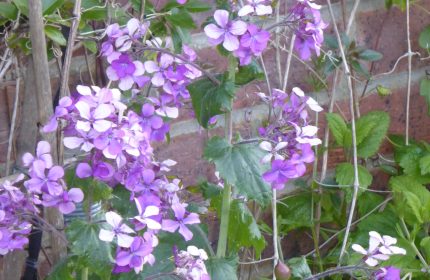Buddleia … Beauty or The Beast?
With its heady scent and striking flowers, Buddleia is an unavoidable sight during high summer – but despite providing nectar for a host of garden insects has the butterfly bush become a purple plague? Liam Creedon reports
Buddleia is the ‘Banksy’ of the plant world. Like one of the celebrated graffiti artist’s provocative works, the appearance of this urban gorilla can transform our unloved, derelict corners into places of unexpected beauty.
And in high summer, this beauty is almost unavoidable as our gardens, waste grounds, towns, cities and railway lines are daubed in deep purple.
For Buddleia is an incredibly tenacious survivor. In little more than a century, it has successfully spread out across the UK to become one of our most noticeable and striking shrubs.
It is on our rail network that this plant, originally from China, is most noticeable. Buddleia forms towering stands along rail lines and embankments, bestowing normally humdrum surroundings with exotic splashes of colour.
Brought to the UK in the late 19th Century, the plant found the dry, stony environments of the British railway system very similar to that of its Himalayan homeland and, as a result, it spread like wildfire.
With astonishing speed, Buddleia marched across the UK using train lines as de-facto plant super highways, spreading out to nearby wastelands and then out across our urban landscape.
And its presence quickly attracted butterflies in such numbers that the shrub became equally well known as the butterfly bush.
With multiple, nectar-rich flower heads, Buddleia attracts many species of widespread butterflies, moths and pollinating insects. The spectacle of Peacocks, Red Admirals and Small Tortoiseshells thronging around the plant has become one of the quintessential sights of British summertime.
Buddleia’s popularity with butterflies has seen garden centre sales soar as people seek out the bushes to attract the colourful insects. As well as dominating waste grounds, the plant is now well on the way to dominating our gardens too.
There are many types of Buddleia, but by far the most widespread variety is Buddleja davidii named after the French missionary Pere David who discovered the plant in 1869.
But it is with this variety that the problems begin. So successful has Buddleja davidii become, that in many quarters it is viewed as a purple plague and a serious ecological problem rather than a useful nectar source.
Classed as a non-native invasive, Buddleja davidii has become widely naturalised in the countryside and there are concerns that the plant is invading wildlife habitats such as brownfield sites which are important for insects. The plant can also form in dense stands which eliminate other plants.
Entomologist Richard Jones explains: “It is hugely invasive, strong-growing and a thug of a plant. It’s vigorous growth and dense leaf architecture soon overshadows and shades out the smaller annual plants that actually provide much of the floral diversity of brownfield sites.”
He suggests waging war upon Buddleja davidii: “We have to deal with it fairly ferociously, to combat its vigorous growth. Where it becomes a problem by scrubbing over more valuable habitats, it should be cut back ruthlessly.
“We must get over the simplified idea that just because it attracts a few pretty butterflies it must be a ‘good’ thing. Ecology is much more complex and we should not shy away from trying to tell people that although it may seem counter-intuitive at first, removing buddleja will offer benefits in terms of broader biodiversity in the long run.”
But at a time when many bee species are in free-fall, three quarters of butterflies have declined and many of our native wild flowers are under unprecedented threat from habitat loss, Buddleja davidii still plays a role in providing widespread nectar-feeding insects with food. The much-loved garden favourite, the Small Tortoiseshell, has suffered from a worrying slump during the last 10 years and Buddleia has a role in providing nectar for this beleaguered insect.
Wildlife charity Butterfly Conservation recommends planting Buddleia in gardens alongside native nectar sources but suggests the plant is dead-headed after flowering to prevent seed dispersal – a view shared by the Royal Horticultural Society (RHS).
Guy Barter, chief horticultural advisor at the RHS, explains: “Buddleja davidii is very popular with the public and with gardeners. It has sold steadily, several cultivars have been awarded the RHS AGM which is given to plants that are excellent for ordinary use, reasonably easy to grow and available to buy and we have 29 different cultivars in our garden at Wisley in Surrey.
“In recognition of its tendency to spread, for those already growing Buddleja davidii we do suggest de-seeding it, though in urban areas there is often so much of it already growing wild on waste land that even if every gardener dead-headed their buddleia, the cumulative effect on its spread would not be very great. However, in rural areas, where Buddleia davidii is not yet growing, wild gardeners keen to stop it escaping can try dead-heading.”
Despite the gnashing of teeth within the environmental movement of how best to deal with the purple plague, Buddleia is here to stay. With careful management it can be kept under control in gardens while providing breath-taking colour and breath-taking butterflies.
Do you have Buddleia in your garden?
Latest posts by Sally - Silversurfer's Editor (see all)
- How to keep your tulips lasting longer - April 25, 2024
- Do you sleep with a snorer? - April 25, 2024
- Holiday hack: How to win a GHA DISCOVERY Titanium status upgrade - April 23, 2024
- 10 Money saving tips for gardeners - April 21, 2024
- Should smacking a child be banned in England and Northern Ireland? - April 17, 2024






















